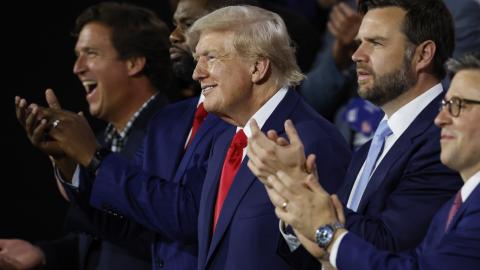As expected, there were no prominent deliverables from last month’s trip to China by U.S. Secretary of State Antony Blinken, who spent three days meeting with officials, students, and others in Shanghai and Beijing. Blinken described his goal as primarily implementing the commitments Presidents Joe Biden and Xi Jinping made at their November 2023 San Francisco summit regarding counternarcotics, military dialogues, artificial intelligence, and people-to-people ties. In a pre-trip background briefing, U.S. officials cited additional goals such as “clearly and directly communicating concerns” and “responsibly managing competition” to minimize conflict and miscalculation.
This “managed competition” framework combines elements of competition, cooperation, and conflict. Though competing with China on most issues, including by making U.S. industries and workers more productive by “Investing in America,” the administration pursues cooperation on select international questions where Sino-American interests overlap. It also aims to avoid military conflict by strengthening U.S. regional defenses and alliances as well as building guardrails against inadvertent confrontation and escalation. Past cooperation has centered on managing climate and proliferation threats, but Blinken mentioned controlling Middle East conflicts as an emerging area of collaboration. Over time, though, the ratio of competition has grown. During his recent trip, Blinken rebuked Chinese assistance to Russia’s military-industrial complex, unfair economic practices, human rights violations, and confrontations with U.S., Philippines, and other non-PRC vessels in international waters.
Despite these tensions, Blinken justified the recent surge in high-level official exchanges with China, which have included a half-dozen U.S. cabinet members and other senior policymakers meeting their Chinese counterparts. Following a lengthy discussion with PRC Foreign Minister Wang Yi, Blinken told the assembled media that, “There’s no substitute…for face-to-face diplomacy in order to try and move forward, but also to make sure that we’re as clear as possible about the areas where we have differences, at the very least, to avoid misunderstandings, to avoid miscalculations.” In addition to these civilian official exchanges, the Biden administration has sought to expand military-to-military and peoples-to-peoples ties among scholars, students, and businesses. While speaking at New York University Shanghai, Blinken poignantly lamented how few U.S. students now study in China.
Blinken’s trip further clarified that the administration will essentially continue its current approach toward China if Biden wins reelection. Though deeming its China policy as largely successful, a second Biden administration may seek to expand the scope of its mini-multilateral partnerships, such as the Australia-United Kingdom-United States (AUKUS) defense technology partnership and the Quadrilateral Security Dialogue (“the Quad”), to encompass more areas and partners. The administration is also preparing additional restrictions on China’s access to Western advanced technologies, especially sophisticated semiconductors, while pressing European and Asian countries to impose similar limitations. A second Biden administration will probably maintain tariffs on Chinese imports, augment support for U.S. industries competing with Chinese enterprises, and intensify efforts to make its regional economic agenda more effective.
A recent report by the Center for American Progress (CAP) generally endorses the “progressive, principled, and pragmatic approach” of the Biden administration. The Center, which enjoys strong ties with the Biden team, favors further investing in U.S. strengths, such as American workers, democratic values, and international alliances. Though critical of Chinese government policies, the CAP team argues that the importance and complexity of Sino-American relations “require direct, regular U.S.-China senior-level exchanges.” Furthermore, the report argues against increasing the U.S. military budget to confront China, favoring instead making the Pentagon more efficient within existing resource constraints, reinforcing U.S. alliance ties, reassuring Beijing about the benign U.S. intentions regarding Taiwan, and pursuing risk reduction through dialogue with the Chinese military. Conversely, these progressive authors see cooperating on climate issues as imperative given that China and the United States generate the largest aggregate carbon emissions but also many of the most efficient novel energy technologies and practices.
Though opposition to Chinese government policies enjoys rare bipartisan support in Washington, a second Trump presidency is unlikely to continue the Biden approach. Experts linked to Trump have faulted the Biden approach for pursuing an overly narrow “transactional approach focused on resolving specific issues” through targeted negotiations and agreements, which these experts argue is ill-suited to manage China’s full-court press to discredit the United States and its values. Instead, Biden’s critics aim to “win” rather than “manage” Sino-American competition.
Specifically, they advocate highlighting rather than obscuring Sino-U.S. political and ideological differences, embracing rather than eschewing bilateral tensions, deemphasizing cooperation on climate and other global issues, overtly striving to keep Taiwan independent from Beijing, and manifestly seeking to curtail China’s economic growth and military power. In their view, the United States needs a rapid defense buildup to avert an impending Chinese invasion of Taiwan while laying a foundation for long-term U.S. military superiority. They want to pursue proactive diplomacy regarding China through a position of strength, disabuse Chinese leaders of thinking they can challenge a complacent West with impunity, challenge malign Chinese information controls, repeal Beijing’s permanent normal trade relations status while raising tariffs and other barriers to Chinese access to the U.S. economy, and to compete more vigorously with Chinese global influence tools such as TikTok the Belt and Road Initiative.
Partisans of this “New Cold War” framework look back to the Reagan Administration’s policies toward the Soviet bloc for inspiration and guidelines. They see China as a similarly ineluctable ideological adversary competing for global primacy with the United States. They admire how Reagan brought moral clarity, societal mobilization, calculated risk-taking, and an unbridled commitment to the struggle. Attributing the collapse of international Soviet Communism to Reagan’s policies, they aim for a comparable outcome regarding China.
Though sharing many of its goals, critics of the “New Cold War” framework consider it too ambitious given U.S. capacity limits, opposition among many U.S. global partners to an overtly confrontational approach, and uncertainty that it would yield more favorable results. Nonetheless, support for this approach could grow as long as bilateral relations remain so troubled and the prospects for long-term ideological, economic, and military competition between China and the United States remain so great.




















